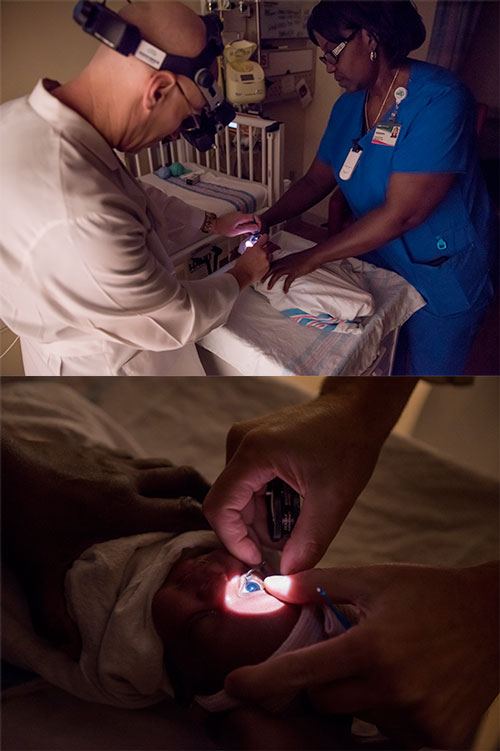 Retinopathy of prematurity (ROP) occurs when abnormal blood vessels grow over the retina and may lead to blindness in premature babies.Premature babies face an increased risk of visual loss from a condition called retinopathy of prematurity, but a screening program conducted by University of Alabama at Birmingham Callahan Eye Hospital ophthalmologists is helping cut negative outcomes by half.
Retinopathy of prematurity (ROP) occurs when abnormal blood vessels grow over the retina and may lead to blindness in premature babies.Premature babies face an increased risk of visual loss from a condition called retinopathy of prematurity, but a screening program conducted by University of Alabama at Birmingham Callahan Eye Hospital ophthalmologists is helping cut negative outcomes by half.
Oxygen is toxic to underdeveloped blood vessels in the retina, often causing scar tissue that can shrink, wrinkle and lead to retinal detachment in severe cases. First diagnosed in 1942, ROP — which usually occurs in both eyes — is among the most common causes of visual loss in childhood and can result in lifelong vision impairment and blindness. It occurs almost exclusively in premature babies under 34 weeks and less than 1,500 grams (about 3.3 pounds). The severity and likelihood of developing ROP increases sharply toward the smaller extremes of age and weight.
Not all premature infants develop ROP, and many who do tend to heal on their own. However, a percentage with milder, stage 1-2 ROP will progress to the crucial stage 3 of the condition — the threshold where visual loss becomes more likely and treatment is recommended. If ROP is left untreated and progresses to stage 4-5, some degree of permanent visual loss or even blindness is typical.
“We can’t tell which babies with milder stages of ROP will go on to the severe stages, so we have to watch all of them to see which are getting better and which are getting worse,” said Martin Cogen, M.D., one of several Callahan ophthalmologists who share bedside screening rounds for 20-30 premature infants each week at the Continuing Care Nursery in the UAB Women and Infants Center.
The screening process is relatively simple and quick. With help from a nurse, the physician applies a dilating drop and observes each eye with an indirect ophthalmoscope, looking for signs of ROP or determining its stage. If ROP is observed to have reached stage 3, retinal specialists from Callahan are brought in to conduct treatment.
Two treatments for ROP are available. Laser therapy began more than a decade ago, and in the past few years, physicians have started using a growth factor inhibitor called Avastin to halt the development of the immature retinal blood vessels.
“The cutting edge right now is figuring out how to combine Avastin with the laser — the ideal combination, the timing and in what order they should be done,” Cogen said.
Cogen and colleagues also screen premature infants each week at other area hospitals.
According to the National Eye Institute, 14,000-16,000 premature infants are affected by ROP each year, and it is severe enough to require medical treatment in roughly 10 percent of cases. Even with increasingly effective treatment, ROP causes blindness in 400-600 infants in the United States annually.
There is very little risk associated with treatment, though peripheral vision is affected in a small number of cases.
“No treatment is 100 percent effective, but we have been able to cut the bad outcomes by half,” Cogen said. “In the past year or so at UAB, not a single baby has ended up with permanent visual loss due to ROP.”